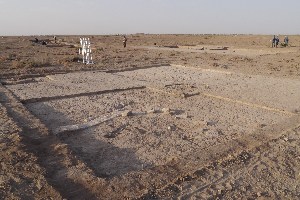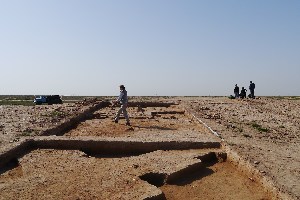Gurukly Shaheri
Archaeological research in early Muslim settlement Gurukly Shaheri, which is a part of Gurukly Depe archaeological site, started in March 2012 as a part of research project "Reconstruction of the process of Central Asian urban-type settlements formation during the early Muslim period" financed by the National Science Centre of Poland.
Gurukly Shaheri archaeologically forms a complex of several hills scattered around an area of about 5 hectares. A large rectangular building located in the southeastern part of Gurukly Shaheri has been selected as an object of the study. Results of geophysical survey and the first excavations conducted in the area allow to develop a preliminary reconstruction of the building. Its plan consists of two rectangular courtyards with three gates – aivans located on a single axis. Western aivan is formed by the main gate, slightly extended behind the walls. The second aivan is the middle gate, which alongside a number of rooms separates two courtyards. The third aivan closes the eastern courtyard and links two parts of an arcade surrounding the courtyards, which is called rivaq. Courtyards and rooms are surrounded by a 1.5 meters thick wall reinforced on short sections by semicircular buttresses. Unfortunately, the northern part of the building and all of its corners have been destroyed in the modern times. Therefore, at this stage of the research, the existence of additional fortifications in the form of turrets at the corners of the building can only be presumed.
Axial arrangement of aivans, adjacent to one or two courtyards, is relatively frequent in the monumental early Muslim architecture. This model was primarily applied in caravanserais, stops for the travelling caravans. Therefore, building in Gurukly Shaheri is probably the remains of one of such caravanserais built in the eleventh century along the famous Silk Road.
Archaeological material, acquired as a result of field survey and excavations, consists primarily of pottery covered with green glaze as well as glazed pottery with painted decoration, stylistically resembling the pottery from Samarkand and Nishapur. In addition, there have been discovered a significant number of fragments of small vessels without glaze but with an impressed decoration and fragments of large vessels without glaze and mostly without any decoration, which were designed for everyday use. Undoubtedly further works within Gurukly Shaheri settlement will allow to determine more accurately the time of its construction and the period of functioning of the caravanserai. Hence the objective of further excavations will be to unearth the main gate, identify the limits of the first courtyard and determine the location of one of four turrets at the corner of the building.
Research is supervised by Monika Różanska-Kardaś, M.A.
Location of the site – 36º 36’ 49.36” N; 61º 13’ 53.40” E
Learn more about Gurukly Shaheri site:




